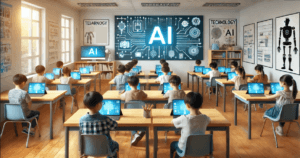China Trains 6-Year-Olds in AI to Shape Future Tech Leaders
China has launched a new initiative to introduce artificial intelligence (AI) education to young students, starting at age six. As part of this program, primary and secondary schools in Beijing will offer at least eight hours of AI classes annually, covering topics like chatbots, AI concepts, and ethics. The Beijing Municipal Education Commission plans to integrate AI into existing subjects or offer it as a standalone course. This effort aims to foster technological innovation and maintain China’s competitive edge in the AI industry. Inspired by successful tech leaders from Zhejiang University, China hopes to develop future AI experts through early education.
Other countries, including Estonia, Canada, South Korea, and the UK, are also incorporating AI into their educational systems. Estonia has partnered with OpenAI to introduce ChatGPT Edu for secondary schools, while Canada and South Korea have integrated AI tools like AI-powered textbooks. The UK has even introduced “teacherless” classrooms where students use virtual reality and AI platforms. These global moves reflect a growing trend to prepare students for a future shaped by AI advancements.

China Trains 6-Year-Olds in AI to Shape Future Tech Leaders
China has taken a significant step to integrate artificial intelligence (AI) education into its school curriculum, aiming to cultivate technological proficiency among young students and solidify its position as a global leader in innovation. Beginning this academic year, primary and secondary schools in Beijing will introduce mandatory AI classes, providing students as young as six years old with at least eight hours of instruction annually. These classes will cover foundational concepts such as how chatbots operate, the basic principles of AI, and ethical considerations surrounding the technology.
The initiative, spearheaded by the Beijing Municipal Education Commission, emphasizes integrating AI education into existing subjects like science and information technology or offering it as a dedicated course. Beyond Beijing, China plans to establish a nationwide, multi-year AI curriculum, develop standardized teaching frameworks, and build support systems to ensure schools have the resources and training needed to deliver effective AI education.
This effort aligns with China’s broader strategic vision to dominate the global AI landscape. By introducing AI concepts early, the country aims to nurture a generation of innovators capable of advancing cutting-edge technologies. The initiative draws inspiration from successful models like Zhejiang University, which has produced influential tech leaders, including Liang Wenfeng, co-founder of the AI company DeepSeek. Early exposure to AI is seen as critical for fostering creativity, problem-solving skills, and a deep understanding of emerging technologies—qualities essential for maintaining competitiveness in fields like automation, data science, and machine learning.
The curriculum’s design reflects a balance between technical knowledge and ethical awareness. Younger students will engage with age-appropriate activities, such as interacting with simple AI tools and discussing real-world applications, while older students may explore coding, algorithm design, and the societal implications of AI. Ethics will form a core component, encouraging students to critically examine issues like data privacy, algorithmic bias, and the responsible use of AI in areas such as healthcare and education. Schools will also collaborate with tech companies and universities to provide hands-on experiences, such as workshops or internships, bridging the gap between classroom learning and industry practices.
China’s push for AI literacy mirrors similar efforts in other nations. Estonia, for instance, has partnered with OpenAI to offer ChatGPT Edu to secondary schools, enabling students and teachers to experiment with generative AI tools under guided supervision. In Canada, schools are piloting AI-powered textbooks that adapt content to individual learning styles, while South Korea has introduced virtual reality (VR) classrooms to simulate immersive AI-driven environments. The United Kingdom has integrated AI into STEM programs, emphasizing coding and robotics to prepare students for careers in tech-driven industries. These global initiatives highlight a shared recognition of AI’s transformative potential and the need to equip future generations with relevant skills.
For China, the stakes are particularly high. The country views AI as a cornerstone of its economic and geopolitical strategy, investing heavily in research, infrastructure, and talent development. By embedding AI education into schools, China hopes to address a projected shortage of skilled professionals in the tech sector while fostering homegrown innovation. The government has also launched competitions, hackathons, and innovation hubs to incentivize student participation and showcase emerging talent. These efforts are complemented by policies promoting public-private partnerships, ensuring that educational institutions remain aligned with industry needs.
Critics, however, raise concerns about the challenges of implementing such an ambitious program. Rural schools, for example, may lack the funding or technical infrastructure to deliver high-quality AI education, potentially widening the urban-rural education gap. Additionally, the rapid evolution of AI technology could outpace curriculum updates, requiring continuous teacher training and resource adaptation. There are also questions about balancing technical instruction with holistic education, ensuring students develop soft skills like critical thinking and empathy alongside technical expertise.
Despite these hurdles, China’s commitment to AI education underscores its determination to lead the next wave of technological advancement. By prioritizing early exposure and interdisciplinary learning, the country aims to create a workforce capable of driving innovation across sectors—from healthcare and agriculture to finance and transportation. This approach not only prepares students for future careers but also cultivates a societal mindset that embraces technology as a tool for progress.
As nations worldwide race to integrate AI into education, China’s strategy offers a glimpse into how systemic investment in STEM fields, coupled with ethical guidance, can shape a nation’s competitive edge. The success of this initiative will depend on its adaptability, inclusivity, and ability to inspire curiosity among students. If executed effectively, it could set a global benchmark for preparing young minds to navigate—and lead—in an AI-driven world.
You must be logged in to post a comment.